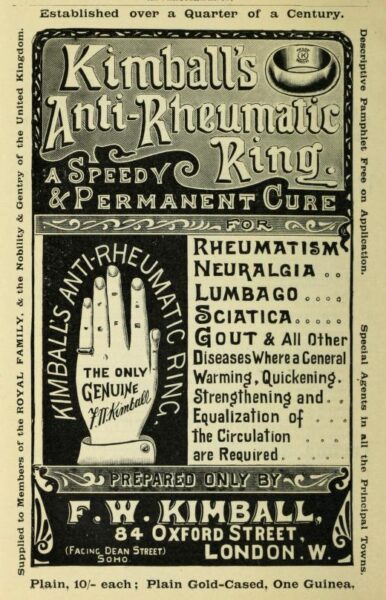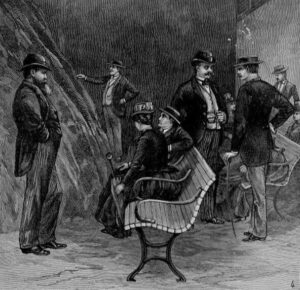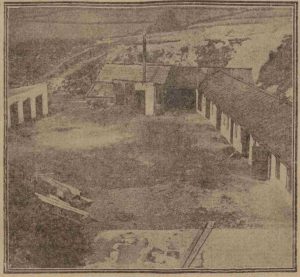Source: The Penny Illustrated Paper and Illustrated Times, Sat 26 January 1895. To view this rather fine-looking gentleman in full technicolour glory, click this ad from the National Archives.
Allcock’s Plasters had their origins in an invention patented in the US in 1845 by Horace Day and William Shecut. (Day was a wealthy manufacturer of rubber goods but in 1846 was sued by one Mr Goodyear for an infringement of a patent and lost $500,000.) The porous plaster patent described the ingredients and method thus:
We first cut five pounds of India-rubber into fine shreds and boil it an hour in common soft water to soften it. We then drain off the water and put the rubber into a tin or copper vessel which will hold at least sixty gallons, and pour into it a sufficient quantity of spirits of turpentine to cover the gum completely, adding from time to time more spirits of turpentine as the gum soaks it up. This process may be hastened by placing the vessel over a water-bath. When the rubber is sufficiently dissolved to admit of its being pressed through a fine wire seive [sic] is may be set aside for use. We next simmer four ounces of Capsicum annuum or cayenne pepper in a quart of spirits of turpentine about one hour and strain it with a portion of this tincture. We grind a pound of litharge on a slab or in a paint mill, mix it with the remainder of the tincture of cayenne, and add to it six ounces of balsam of Peru. Then we melt a pound of pine-gum and add spirits of turpentine until it is thin enough to strain when nearly cool, and, lastly, mix the whole of the preceding preparations together until the mixture is of uniform color, without specks or lumps. It is then ready for spreading on any suitable material. Cotton cambric or muslin will answer the purpose very well.
Holes were punched in the product – the colour image in the National Archives link gives some idea of what it looked like. Thomas Allcock, a British-born druggist living in New York, appears to have acquired the rights almost immediately, and a few years later the company went into association with Benjamin Brandreth (great-great-grandfather of Gyles), whose Brandreth’s Pills were already famous.
The plasters were not only supposed to to help lumbago – other adverts suggested using them for such varied disorders as quinsy (you had to put a strip of plaster under your chin, stretching from ear to ear), diabetes, St Vitus’s Dance, epilepsy, dyspepsia, diarrhoea, coughs and colds, asthma, pleurisy, whooping cough, consumption, ruptures, sciatica, paralysis, rheumatism, tic douloureux and kidney problems.
The ads boasted that it only took 2 seconds to apply the plaster. Getting it off, however, was another matter. Dick’s Encyclopaedia noted in 1872 that:
These plasters adhere very firmly, frequently requiring the application of heat (by means of a hot towel or warm flat-iron), for their removal.
One 1876 ad advised customers to ‘Beware of piratical imitations.’ Presumably these were called Arrrrlcock’s.




The Anne of Green Gables series features both mustard and porous plasters which I’ve thought fascinating for many years though until this day I hadn’t looked them up on the internet. So glad I stopped by here. Those porous plasters sure sound dreadful to remove!
I bottle a bottle of rum in the virgin islands and had news paperaround it with this article
Does anybody know what kinda rum is wrap up in this newspaper.it from 1838 newspaper clipping talking about the quack doctor